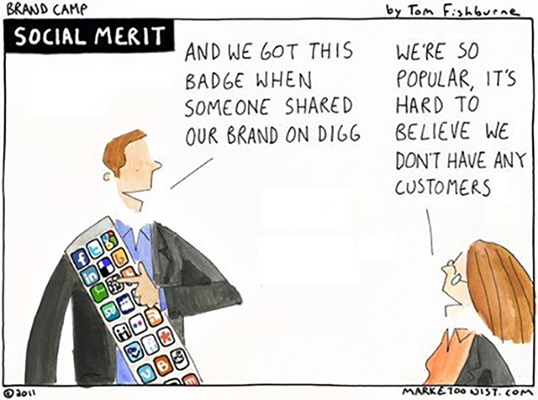By Patti Hill
 Wikipedia says social media “are primarily Internet-based tools for sharing and discussing information amongst humans.” They are manifested in tweets, followers, blog posts, friends, videos, etc. and some social experts believe they are every bit as credible as quotes or mentions in elite or industry news outlets.
Wikipedia says social media “are primarily Internet-based tools for sharing and discussing information amongst humans.” They are manifested in tweets, followers, blog posts, friends, videos, etc. and some social experts believe they are every bit as credible as quotes or mentions in elite or industry news outlets.
They are sadly mistaken.
People communicate and publish whatever they like whenever they like on social sites. News can be posted faster than traditional news outlets, but because boring doesn’t work on social media, news is glorified and gory-fied, which puts credibility in question. From videos to 140-character tweets, opinions and content run amuck, creating crowded arenas where verification of resources or content can be challenging. According to an experimental study from the Media Insight Project, a collaboration between the American Press Institute and The Associated Press-NORC Center for Public Affairs Research, trust is now determined less by who creates the news than by who shares it.
Social content also has limited lifespans. YouTube videos last about 20 or so days; a LinkedIn post is good for 24 hours; Facebook visibility lasts about five hours; and a tweet is relevant for roughly 18 minutes. There is so much content being posted on these channels, it’s a fight to keep up. In order to get more interest, more posts have to be made.
The data deepens.
Although social media has matured, marketers have not necessarily advanced along with it, in spite of all their claims. Social media takes time and requires thought before posting. When not fully vetted, corporate failures and blunders can spread as quickly as a bad rash.
Traditional media, on the other hand, continues to be consumed regularly by millions. It’s said the people who still read newspapers are among the wealthiest people in the United States. Warren Buffett, for example, reads five a day.
Over the last five to 10 years, people have been talking about how traditional media will become obsolete, but it hasn’t happened—and traditional media still play a vital role in modern journalism.
In fact, traditional outlets are the foundation for any business-to-business public relations campaign. All national-level, high-circulation outlets have specialized, in-depth reporters who cover particular issues, sectors, organizations and institutions. Depending on demographics and beats, they regularly cover issues relating to national or world business, over a range of topics.
Because of their high profile and broad readership base, these types of outlets cover industries in three general areas: 1) topical high-impact news; 2) economic news and trends; and 3) industry news that has a propensity to either highlight an overarching movement within a sector or specific topics validated by an outside source. Because of their readership, they have the unique ability to generate a surge of interest in companies, products, services and industry segments.
Industry trades are also more relevant and valuable than ever before. In addition to their ability to convey thought leadership, business and industrial customers garner insights into industry direction and a qualitative sense of specific industries or sectors. Authors, companies, and conversation participants engage in trade publications from a transparent position, as well as those are looking for products and services and have solutions to offer—they all construct the conversations and content that orbit these types of publications.
News services and syndicates, such as Associated Press, Knight Ridder, Reuters, United Press International, Feeley News Bureau and Bloomberg News also are valuable for newsmakers. They are leading providers of critical information to traditional media outlets, businesses, governments and researchers worldwide. They provide news and feature stories, photos, print and web news, feature graphics and paginated news to organizations around the world.
The glaring difference between traditional and social media is investigative reporting versus narrative reporting. Social media posters rarely delve deeply into reporting; rather, they rely on user-generated content. When everyone is a self-proclaimed journalist and interactions are immediate, trust and credibility are eroded.
This creates a situation where traditional media, including national newspapers, network and cable TV and radio news, will always have a place in today’s society—particularly with traditional news outlets continually transiting and transforming. By leveraging digital, mobile and social platforms, they remain relevant and provide further platforms for competing with and complementing social media outlets.
Patti Hill, an irreverent, entrepreneurial executive with an appetite for shaking things up, founded Penman PR in Atlanta three weeks after 9/11. She is simultaneously intense and laid-back, which is a refreshing change from public relations’ traditionally conservative culture. Her passion for complex technologies has resulted in the firm’s representation of some very interesting clients and her penchant for disruption creates a unique space for Penman PR’s style of executive representation in ways no PR antecedent could. For additional information about Penman PR: http://www.penmanpr.com/






